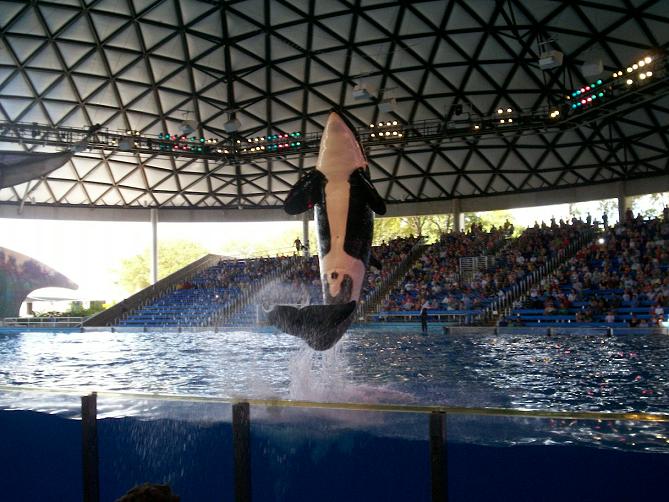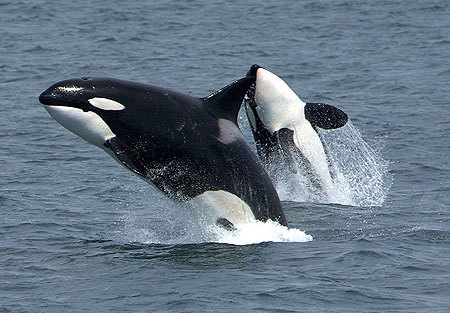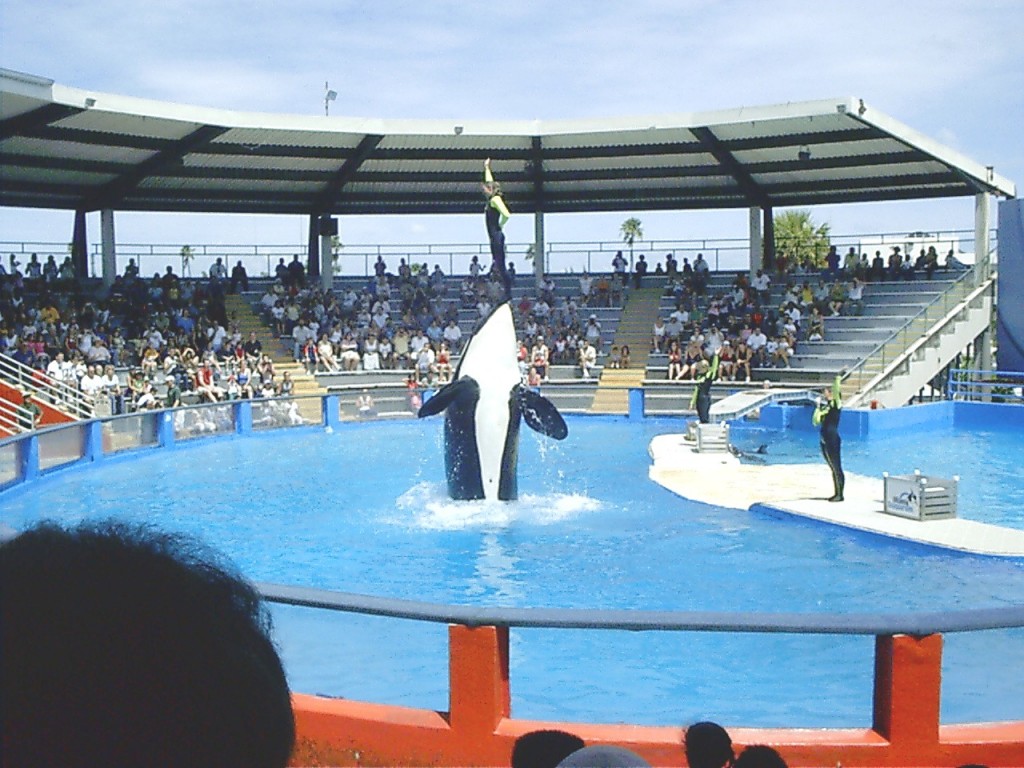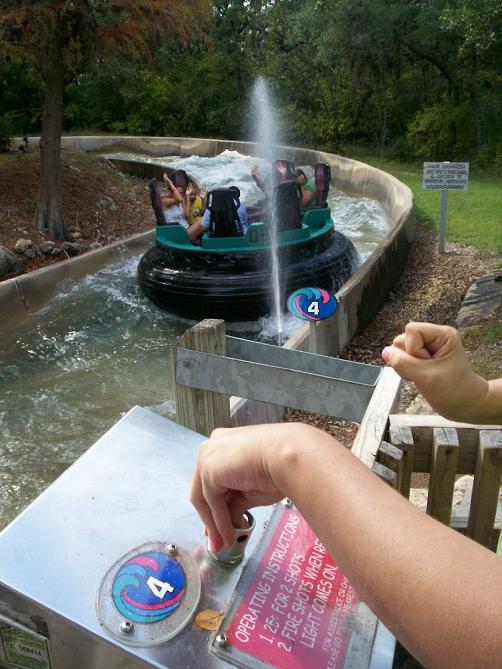By Mitchell Warren
The waves were rippling slowly in a brightly colored, slightly stagnant pool. A hundred tiny faces soared with expression as a killer whale followed his cue and twirled into the pool with all the precise timing of a kitten performing an adorable little belly roll. Hands clapped and voices cheered as the orca gloriously emerged, entertaining its audience and delivering a personalized Free Willy moment for less than $50 a ticket. Imagination-deprived children were fascinated while blase moms approved of SeaWorld’s non-threatening, G-rated show. The orcas truly comprehended the idea of American commerce, if not the full science; they provide the service, the audience approves, the trainers provide the fish.
Amid the happy human faces and the sunless blue waves, Tilikum, a twenty-eight-year-old bull orca, saw a flailing tail of human hair that flew almost mockingly from side to side. The polite thing to do would be to follow the trainer’s lead and ignore the tail of temptation. To do so would be against whale philosophy, which is very logical and largely fishonomic. At some point while under the water, Tilikum decided that the consequences of his actions would be worth the resonate statement.
Tilikum began his session with Dawn Brancheau stridently and swam with unusual fury and abandon. He came back around, lifted his 12,000 pound body in the air, and grabbed that swishing tail, dragging the woman into the pool. As Tilikum held her spinning body under water, he pondered what the human world might make of this rebellious act. Perhaps they would defend his actions, citing that whales, like capricious kittens, really don’t understand their own strength. Perhaps they would write that the whales seem agitated that morning. All that Tilikum truly realized at that moment, as he violently thrashed her body under the water, all too aware that the trainers never seemed to linger in the pool as long as his own species, was that he wouldn’t get a fish today. What a powerful lesson to teach to the young, Tilikum figured, he being the only mature orca at the Orlando show and the resident stud of SeaWorld, siring multiple calves.
Regardless of what the world would later write about the murder, the two dozen spectators who witnessed the assassination were horrified. Despite the efforts of other trainers to hoist the whale and the dying woman out of the water, Tilikum claimed his third human victim. As spectators were shooed away by the SeaWorld staff, one young boy in the audience tried to comprehend the violent images that he saw. Mom told him that the whale was only playing with the trainer, while all the experts from SeaWorld claimed that the whale didn’t understand his own actions and made a mistake. A tragedy indeed…one that couldn’t have been predicted and that now apparently has no explanation.
I don’t know who that young boy was, but I’m glad he wasn’t a young Mitchell Warren.
SeaWorld Memories
Now, we the wide-eyed children who have flocked to SeaWorld every year hoping to commune with aquatic nature, are left to reconcile conflicting emotions. I have many fond memories of SeaWorld and the countless cast of Shamus I have met and been soaked by over the years. I remember the first time I saw a killer whale in person and observed the majesty of its leap, a truly unnatural if still nature-based experience, far more stirring than any manufactured image I watched on the big screen. The fact that we called this whale, a fourth or fifth generation calf, by the longstanding name Shamu seemed to endear the orca species to us. For a time, we thought we had communication—even friendship—with a creature totally foreign to our own.
I remember the joy I had watching walruses and sea otters “act” with humans and steal the comedy show, as the human beings seemed to be the most contrived and annoying species on stage. I remember the pool of stingrays and the tub of dolphins that would crackle at you (in a friendly way of course) for a fish. Indeed, the illusion of interspecies communication is SeaWorld’s greatest lure.
I am left with the problem of rationalizing Tilikum’s actions—indeed his statement—as harmonious with the peaceful memories of a SeaWorld experience. Are we to believe that this was one unique killer whale, a true exception to the species, just as the human civilization has produced its own rapists, murderers and assassins? Or should we entertain the thought that maybe this whale had the courage to do what other orcas or dolphins could never do—resist human oppression? Was this a serial killer whale or the Che of sea-bound mammals? Are we witnessing a revolution in its infancy stages? Is this yet another consequence of global warming? Or, was this just a random act of violence so strange it can only be chalked up to the eccentricity of nature gone awry?
All of these existential questions didn’t mesh too well with my pleasant memories of blissfully floating manatees, happy polar bears and hordes of penguins eagerly awaiting the “rapture” of their next meal. We always assumed the animals were happy in SeaWorld, or something close to happiness—they were safe from the wild and they had as much yummy treats as they could possibly eat. Our instincts told us that animal instincts were a world apart from our own. Animals have no ambition, no dream, no memory or significance other than to move around in circles for the amusement of a superior species.
The thought occurred to me once or twice while I looked into the beady eyes of a stingray one enjoyable summer, the bizarre creature just inches away from my own. “Why did your people kill Steve Irwin?” I thought of asking it so, but figured I would get no response, whether or not stingrays understood English by now. If they did, they were not going to reveal such a fantastic plot to little old me. I suppressed such negativity in hopes of making my vacation a fully positive experience.
The Ramifications of Premeditated Orca Killings
The murder of yet another human at the hands of “trained” wildlife forces you to consider many disheartening questions, the likes of which psycho-mommies would not let young ears hear. How truly noble is a place like SeaWorld where animals are treated like “celebrities”? These creatures are technically being held captive against their will but they are also given protection, pampering and a good-paying job. We know that they are not “abused” per say, since SeaWorld trainers make it very clear that they use only positive reinforcement in orca training. In fact, a couple of highly educated guys wrote a book on how to parent a child like an orca. They are presumably hiding their heads in the sink at this very moment.
What are the ramifications of letting a trained animal commit offenses without any form of punishment? This will teach the orca to avoid negative behavior solely because it results in fishonomic deflation. The moment the whale realizes that it doesn’t need fish at this very moment, some sort of whale existentialism similar to our own we reckon, the whale realizes its power. So it occasionally takes a human life, curious as to what our level of non-reaction will be. Perhaps after a few more maulings of SeaWorld employees, the animal will start to learn that murder jeopardizes career—a lesson we humans have only recently grasped ourselves.
As much as it pains to me to side with PETA (who I can’t fully endorse for various reasons) they do effectively make their case for the banishment of SeaWorld and the release of orca whales. Debbie Leahy, PETA’s Director of Captive Animals, says the death of Dawn Brancheau was preventable, and that if SeaWorld continues to keep orcas in captive, a murder “will happen again.”
Leahy told CBS News “It was a very angry, very frustrated orca who snapped and decided to take it out on a person. It’s not surprising when these huge, smart animals lash out…this is not the first incident in which a trainer has been harmed by an animal who has been deprived of any semblance of life.”
Leave it to PETA, who is historically guilty of elevating animals to above human status, to actually admit that a confused orca is a murderous whale. Still, their point is understood—how can we as civilized human beings expect this subjugated species to be content in life by repeatedly performing stupid tricks for food? The same food for which, if they were born and left in the ocean, they could find and eat within minutes.
The issue of what to do with newly released “trained” animals is similarly challenging. If we release all of SeaWorld’s captive animals now, wouldn’t they just perish in the wild? These thoughts vex me, as do memories of a young Mitchell petting dolphin skin for the very first time, both extremes struggling for that definitive association of the word “SeaWorld.”
We have met the first psychopathic whale on record and are forced to reflect on our own behavior. What did society do to push the criminal into abnormal thinking patterns? If we take a revolutionary’s viewpoint, then we have to consider Tilikum as a prisoner of war as opposed just to a murderous orca. Was our treatment of his species justified or were we mistaken from the start?
I imagine a Civil War period America struggled with the same questions. African-American slaves were subjugated and considered as something “less” than Anglo-Americans. While there were a few strong voices that opposed the humiliation and exploitation of black slaves, the majority refused to accept the illogical argument; because, simply put, America felt blacks were not worthy of full American rights as they were subhuman.
Abraham Lincoln was considered a radical for merely suggesting that slavery was a mistaken route, and that blacks should be allowed to return to Africa.
An address by Abraham Lincoln at Springfield, Illinois, on June 26, 1857 [Collected Works of Abraham Lincoln, Vol II, pp 408-9, Basler, ed.]:
“A separation of the races is the only perfect preventive of amalgamation, but as immediate separation is impossible the next best thing is to keep them apart where they are not already together. Such separation, if ever affected at all, must be effected by colonization. The enterprise is a difficult one, but ‘where there is a will there is a way:’ and what colonization needs now is a hearty will. Will springs from the two elements of moral and self-interest. Let us be brought to believe it is morally right, and at the same time, favorable to, or at least not against our interest, to transfer the African to his native clime, and we shall find a way to do it, however great the task may be.”
Now the challenge evolves to fit the 21st century: do these so-called subhuman creatures, the sea mammals who are so talented at doing stupid pet tricks, deserve to be released and returned to their native climate? No one’s suggesting equal treatment, because after all, the right to consume another creature that is stupider than you are is a god-given privilege and a lusty vice no ordinary person could possibly resist. (Hence I should be allowed to eat President Obama, right?) However, someone is suggesting that a separation of the species would probably be appropriate, especially in light of the assassination we recently witnessed. Do we not learn from history? Do we not learn from a process of painful trials and errors to create a more peaceable planet?
New Memories of Shamu
While philosophers and great (rich) men will continue to pontificate on what should be done or could be done, the show goes on. SeaWorld has already stated that Shamu shows will continue as soon as this weekend. The only policy that has changed—temporarily at that—is that trainers are no longer allowed to get into the water with the killer whales. At some point, assuming the other whales don’t take part in an organized revolt stirred up by Tilikum, SeaWorld will allow trainers back into the pool. Furthermore, the park has decided to keep the killer whale and only place sanctions on his performances rather than “firing” him of his duties.
“Finally, a reaction!” thought Tilikum.
As I think back to my jolliest memories of SeaWorld, I find myself not thinking as much about the animal interaction as the human interaction. Whether this is because of my negative associations of SeaWorld overpowering the positives, or because all the orca nonsense has always been overrated circus fare, is unknown to me. What I do remember most about SeaWorld were decidedly human events.
I remember the fun times my parents and I had walking around the theme park and commenting on the absurdity of what was around us. I remember going on two SeaWorld dates with two different women who I foolishly thought were “the ones.” I remember going on a SeaWorld vacation with my future wife, who turned out to be the love of my life. I remember how awful it was to get soaked on the rafting ride, and then how much malicious fun it was to soak people riding those rafts with the water guns.
I remember how bemused I was to hold my own Shamu doll. I remember watching horrifically bad 4-D movies starring Christopher Lloyd that only resulted in me getting soaked by the theater seat. I remember getting the bejesus scared out of me after riding two of the “calmer” roller coaster rides. I remember humorous anecdotes about how my fiancee and I traded shoes because of soreness, and my first and only experience with wearing women’s shoes.
But Shamu himself was not at the top of my list of memories. His world and my own were never quite in-synch. I never understood what it was like to be a circus animal robbed of ambition and drained of spirit. He never understood what it was like to be on the outside looking in, having the world in complete submission. Perhaps for one brief second, the Tilikum I once met, admitted to me that if he were in my place, he would probably do the same thing I did. I know I certainly would act upon my murderous rage if I had to swim a lifetime in his pool.
And so I make my final association of SeaWorld: formerly a living museum of emotional cruelty and now a watery grave. The devastated look on the young boy’s face tells the story. It may be an entire lifetime before that child is able to sort through the paradoxes: a violent mauling of a peaceful killer whale attacking its friendly trainer. Meanwhile, Shamu, the killer whale, swims scot-free.
Some trainers (including Thad Lacinak, a former head trainer at SeaWorld) are already placing the blame on Brancheau, stating that the deceased 40-year-old trainer likely “broke protocol by putting her face so close to that of the whale and letting her hair brush the whale’s face. ‘Sometimes we get too comfortable working with these animals. Sometimes we forget what they are.’”
And so Tilikum, silently, Dexterously, swims across his territory carefully earning trust, respectfully eating fish, and leaping on cue. All the while, he eyes another tail of human hair, those tied locks bouncing back and forth in sarcasm, and ponders the ramifications of a fourth assassination. No, he won’t try it again anytime soon, for that might start a war. But his calves may have heard the message and already learned an invaluable lesson about mankind.
(C) 2010 The Late Mitchell Warren






Interesting. So the prophetic Conquest of the Planet of the Apes plays out with Orcas instead of Apes and Tilikum instead of Ceasar.
We should side with the Orcas now to avoid slavery.
If it’s not too late.
If the whales got together and decided to revolt against humankind, i think i would stay away from beaches and open water. Should they pass their message onto to bears, we’re most likely sunk. At any rate, i don’t believe other animals trundle around with a list of harbored grudges, complete with premeditated plans for getting even like the complex brain biped they are forced to share with. That they think, i have no doubt. Anyone who has raised animals at all can recite remarkable tales of animal behavior; stories that demonstrate independent thought processes.
Whales at sea, including Orcas, don’t generally form a habit of killing people, although ask any seal and he’ll tell you Orcas are very effective killing machines. Why would a wild animal consistently kill off its trainers? Probably to show that its bigger and badder and nothing you can do is going to change this.
I know you’ve heard me say this before, Mitch, but i’ll say it again. You can’t domesticate the wild. It lives by its own rules. Either we learn to adjust to its rules or accept that we are far too domesticated and out of touch with nature to live with it or understand it.
[quote=Karlsie]I know you’ve heard me say this before, Mitch, but i’ll say it again. You can’t domesticate the wild. It lives by its own rules. Either we learn to adjust to its rules or accept that we are far too domesticated and out of touch with nature to live with it or understand it.[/quote]
I have a similar perspective – I think that our little bubble called “civilization” has all but blinded us to the realities of nature: that animals (humans included) will behave like animals and act on their instincts. Unless you provide an outlet for those instincts they will manifest in unpredictable ways, often with negative results.
In this case, the whale was probably acting on its hunting instincts (the way he killed the trainer closely resembles the way orcas kill seals in the wild, so that leads me to think he was acting on an impulse he had been surpressing for a while) – orcas were naturally-selected because they were the best damn hunters in their seas, not because they can preform tricks. Unless Seaworld devises some means for those instincts to be released and redirected (like the way a dog’s hunting instincts are often redirected for tracking prey for human hunters or for duties like “search and rescue”) I think they will have to deal with more incidents like this in the future.
I don’t think I was literally accusing the dolphins or the whales of holding grudges against human beings. It was a metaphorical narrative detailing some of the mixed feelings I had when hearing of it. As domesticating the wild, we certainly shouldn’t. But we do, and then we kill the species off if we get frustrated. The only comeuppance we will ever have is the crazy-assed weather. Kill us all! We deserve it. Hey, just in time for the spring-tornado season.
Mom and Dad took me to the circus when it came to town; I believe (if memory serves) I was around three or four. I squirmed; was unhappy – and finally told Mom, “I don’t like what they’re doing to the animals.”
That was that. We went home.
Clowns are scary; circuses are evil. I’ll throw SeaWorld in with that mix.
Good piece, Mitch. Damn good piece.
-W
@ Will.
We obviously had very similar circus experiences as children. I remember being reduced to tears at the age of seven upon witnessing huge, majestic lions and tigers being forced to jump through hoops… and my fear of clowns predates the Stephen King book, It
@ Karlsie
Like you, I’ve long held that not only we can’t domesticate the wild… we shouldn’t.
I’m fortunate enough to live off the coast of Western Australia were we witness the yearly migration of Humpback whales as they move to and from the Southern Ocean to their breeding ground in warmer northern waters.
To me watching them in their natural habitat is a mezmerising experience and one far more noble and dignified than reducing them to a mere “cash-cow” performing for second rate, defrosted food.
As unfortunate as a human death is, I raised a toast to Tilikum and all his fellow captives across the globe.
In the words of Douglas Adams in his Hitchhiker’s Guide to the Galaxy… “So long, and thanks for all the fish.”
Malice, my own experiences have been with the Beluga whales. Oh my God; when they come sounding into the Cook Inlet! Not even the Dahl sheep, clattering down from the mountains, produce such a beautiful sight. In the wild, they are magnificent. To think our paltry egos would wish to capture them; to tame them; is ridiculous.
A fisherman friend of mine once told me of a whale that came right up to the boat, which isn’t unusual. Many of the marine life, such as whales, sea lions, otters and seals, have figured out that by cozying up to the boats, they receive free fish. What amazed him was that as the whale lifted its head, my friend was staring into its gigantic eye. He said the eye seemed full of curiosity, gentleness, and was somehow human.
Animals in the wild are adept at adjusting to humans. If only humans were so adept at adjusting to them. Instead, we fear the wild. We rope it off and declare in unsafe. We places it in little boxes and try to teach social manners and compliance to our sense of orderly existence. The trembling cowards, faced with the true aspects of nature, run away to hide in their own little, spoon fed cages.
For that thirty dollar ticket, Sea World should build ferries that go out into the ocean to see the whales in all their splendid glory. There won’t be any circus performances, no dizzying rides, no admirable trainers bossing around the giant captives, but they would be able to see one of the most magnificent sights of all; whales swimming freely in the ocean.
I found a video of this here: http://www.goarticles.com/cgi-bin/showa.cgi?C=2631278
Perhaps Mr Colbert should put orcas right up there with the bears on his “threat down”! But co
e on people. Orcas are ment to roam the vast oceans of the world. Let the orcas go before they do start a grass roots movement to take it to the man. And a word to all of you orca, bear and lion trainers out there…these are WILD animals folks. We are not always on the top of the food chain like we’d like to think. I was quicky and quite effectively reoriented to this fact following a close encounter with a great white while surfing in Monterey. Heads up stupid Americans.